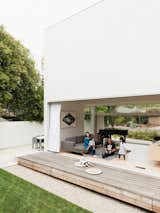The most sustainable element of all is the Lais’ intention to make their first home their last home as well. “Some people have this mentality of getting a starter house, then upgrading from there,” David says. “We just wanted to find a place to live in and then stay there forever.” Eventually they imagine passing the home down to their children.
That heat is then transferred to the old stone walls underneath. From there, the stone slowly radiates the warmth into the interior, keeping it around 70°F even as night temperatures drop to 25°F. A wood-burning stove compensates for cloudy days. (For the thermally-savvy, the polycarbonate has a U value of 1.1 W/m²K).
The house has a small environmental footprint. SHED built it using advanced framing, a technique that cuts down on the use of lumber by 30 percent. Another benefit of the method is that it prevents heat from escaping the home, making it more energy-efficient. Additionally, the architects installed a high-efficiency boiler that preheats water with rooftop solar panels; a heat recovery ventilation system that efficiently controls the climate; and a rainwater retention tank that conserves water.
On all three aboveground levels of the house, outdoor spaces feature as prominently as indoor ones. The backyard is lined with tiered concrete boxes for planting vegetables; the modest top floor—which houses the master bedroom—has a deck wrapping three sides; and in the middle, a 770-square-foot green roof extends off the living area.
Don't miss a word of Dwell! Download our FREE app from iTunes, friend us on Facebook, or follow us on Twitter!
Flywheel Energy Storage
Flywheels are discs or cylinders that spin on an axis in a frictionless enclosure to store power in the form of kinetic energy. When demand for power rises, the spinning can be slowed to release energy to the grid. The advantages of flywheel storage include long life and low maintenance.
Advanced Rail Energy Storage
Based in Santa Barbara, California, Advanced Rail Energy Storage has devised a system that draws energy from the grid to push a train of weighted cars uphill. When demand spikes, the cars are sent downhill, sending power back to the grid by using the turning power of the wheels on each car to generate electricity.
Compressed-Air Energy Storage
Wind energy is used to power compressors that inject air at high pressure into large underground chambers. When demand peaks and the wind flags, the pressurized air is released—often with a small amount of natural gas—to power turbines or generators, producing electricity. The first such plant opened in Germany in 1978.
Pumped-Storage Hydroelectricity
Pumped-storage hydroelectricity is the oldest and most common form of bulk-energy storage. During periods of low demand, energy from the grid is used to move water to an upper reservoir. When demand rises, the water flows down to a lower reservoir through turbines that generate power like a common hydropower station.
The Plumen 001 Baby is the more compact version of the Plumen 001. The Baby’s 9-watt power is equivalent to a 40-watt incandescent in terms of illumination and it has a lifetime of eight years— typical incandescent bulbs last up to one year. CFLs tend to produce harsh light reminiscent of fluorescent lamps, while the Plumen 001 Baby diffuses warm white light.
Lithium-Ion Battery Storage
Lithium-ion batteries were introduced more than two decades ago to power consumer products. More recently, though, utilities have started gathering larger-format batteries in farms to draw energy from the grid when supply outpaces demand then dispatch it back to the system when it is needed most.
Porches are a beloved element of the Southern vernacular and lifestyle, traditionally serving as an extension of the indoors—a shady place to gather, socialize, or share a meal. So when the students of Appalachian State University in Boone, North Carolina, entered the Solar Decathlon, a biennial energy-efficient residential design competition, the iconic space figured prominently in their concept. Here, a canopy of bifacial solar panels covers the porch and provides energy for the home.
A rocket scientest named Thomas Povey applied fins and grooves along the exterior of his new Flare Pans in order to direct the flame to cover more of the pot’s surface area, saving heat energy. The idea of using fins isn’t new — the casing on air-cooled motorcycle engines are coated with grooves to get the surrounding airflow to hit more surface area. Dr. Povey used his knowledge of working on jet engines to apply the same principles to the pots.
Ichijo USA is pursuing new, highly energy efficient projects elsewhere. They will be building all future homes to a level of energy efficiency which is less than half that required by the Washington State Energy Code, and are looking at zero net energy projects beyond zHome. Having a major player, such as Ichijo, in the regional builder mix setting that type of standard would have been unimaginable just three or four years ago. Photo courtesy of Daniel Umbach Architect and Ichijo USA.
During summer, the sun is too high above the home to heat the polycarbonate: the plastic simply reflects the light—and its energy—back into the atmosphere. In fact, during the summer the stone wall absors the interior's excess heat and releases it into an air gap—about 2-4 inches wide—between it and the polycarbonate.
The home's furniture is economical: the table seen here is just a wood board stabilized on two A-frames.
1,541 more photos



































